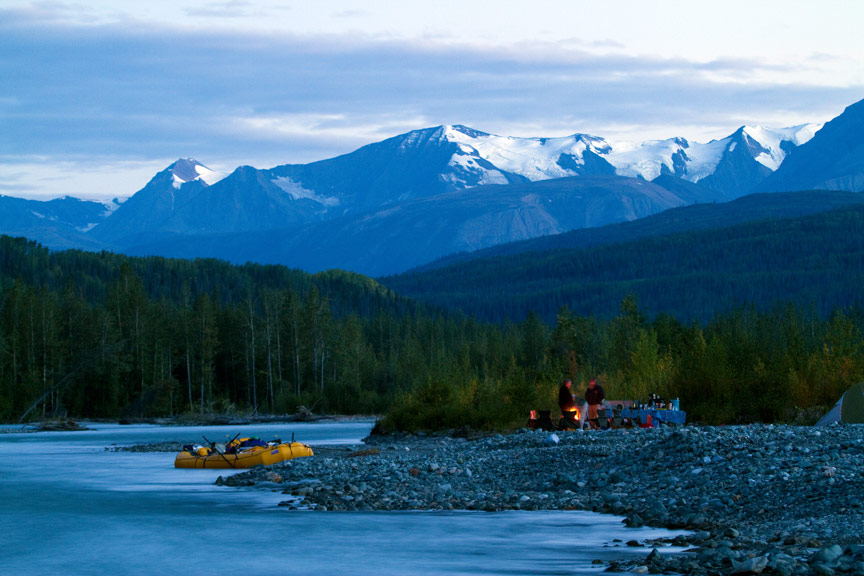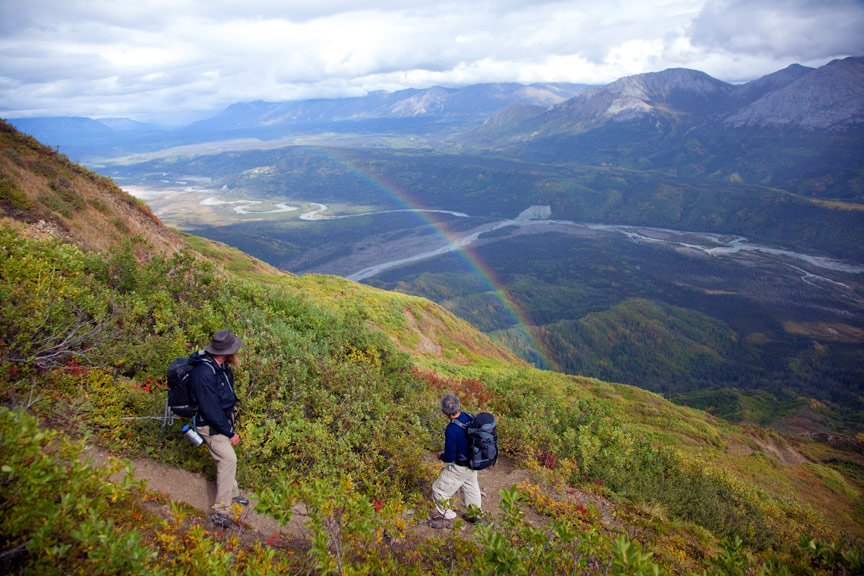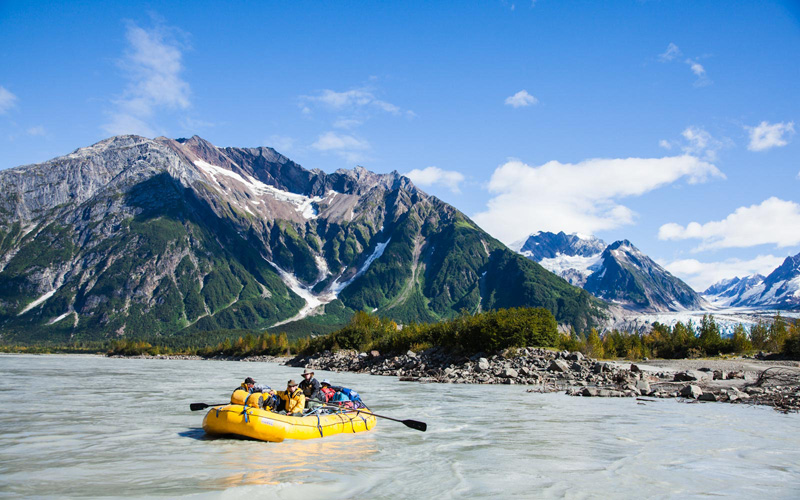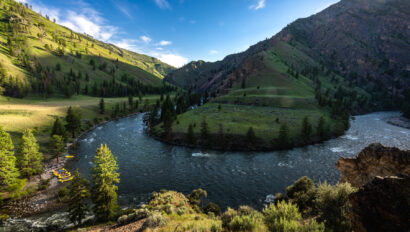How the Tatshenshini-Alsek Wilderness Avoided Mining Disaster


The Tatshenshini-Alsek ranks among the world’s top five wilderness river trips. It’s a scenic rival of Grand Canyon and it bisects North America’s most pristine wildlife region — a Jack London land of wolves and wolverines, moose and mountain goats and Dall sheep, and one of the world’s biggest populations of grizzly bears.
Giant peaks 15,000 feet high gnawed at our vista. So many exist here that most guides cannot keep their names straight. One, however, everyone knows—Windy Craggy Mountain. This pipsqueak tops out at a mere 6,000 feet in British Columbia 15 miles east of the Alaskan border and 10 miles from the confluence of the Tatshenshini and Alsek rivers, not far from our camp.
Windy Craggy could be instead called Mount Doom. This is because Windy Craggy is a Triassic pillow basalt containing 3 percent copper — 100 million tons of it — worth at least $5 billion. Windy Craggy lies in between Yukon’s Kluane National Park and Alaska’s Glacier Bay and Wrangell-St. Elias National Parks and Preserves in a region where mineral extraction was up for grabs. In mid-1993, Geddes Resources Limited of Vancouver pushed for a permit to pulverize the top 2,000 feet of Windy Craggy then gouge its nub into a mammoth, open-pit mine. This meant excavating a staggering 265 million cubic feet of rock by gnawing 60 million pounds off the mountain daily for fifteen years and piping it as slurry 150 miles to port in Haines. From there, Geddes would ship it to Japan.
A simple plan.
The Complication
Too simple. The complication? Windy Craggy is also 40 percent sulfide. When the 375 million tons of crushed tailings the mine would produce as waste became exposed to atmospheric oxygen it would unleash immense quantities of sulfuric acid into the wilderness. This acid would leach out heavy metals like cobalt (0.1 percent of Windy Craggy is cobalt). This combination of acid and heavy metal contamination is so sinister it has its own name, Acid Mine Damage, or AMD. AMD permanently poisons a drainage ecosystem. It devastates fish and the creatures that eat fish—from grizzlies and otters to sea gulls and eagles. AMD is so hideous that already the U.S. was spending $1 million per day to mitigate AMD heavy metals along 4,000 miles of its poisoned streams.
The estimated cost to detoxify Windy Craggy Crater once Geddes sucked it dry stood at $1 billion. If nothing went wrong.
Geddes planned to hide their hundreds of millions of tons of sulphide tailings from atmospheric oxygen under a 2.5-mile long reservoir three miles from the river. The problem? Windy Craggy sits in the most active earthquake zone in North America, one triggered by the Fairweather Fault. In 1899, the second largest earthquake in North American history, 8.6 on the Richter scale, hit 75 miles northwest of Windy Craggy and lifted entire mountains 47 feet higher! The quake also sent glaciers slamming down their canyons half a mile in five minutes. In 1958, a Richter 7.9 quake originated 30 miles from Windy Craggy and shook it like a rag doll.
The upshot? No dam can withstand such force. Indeed, British Columbia’s Commission on Resources and Environment (CORE) estimated that an ecological disaster would occur here every twelve years.

It Gets Worse
But Geddes’ overall plans proved even more frightening. They aimed to build hundreds of miles of roads, bridges, and pipelines through virgin wilderness and to construct a town and processing plant on site. These alone would be the ecosystem’s kiss of death.
An economist might argue that losing some wilderness was worth the metals. Yet an economic analysis of Geddes’ mine made no economic sense even in the short run. To gross $65 million non-sustainably per year for fifteen years, the mine would permanently devastate sustainable fisheries worth almost as much, forever. Fisheries in the Tatshenshini-Alsek system and the Lynn Canal into which Geddes planned to dump slurry effluent are worth $49.5 million yearly. Spills from Geddes’ slurry line would also endanger the world’s largest concentration of bald eagles—3,500 of them—who converge on the Chilkat River and fuel a lucrative tourist industry.
Grizzlies Threatened
The icon of the north is the grizzly mainly because men have wiped it out nearly everywhere else south into Mexico. As with sex, religion, and politics, grizzly bears never plod a neutral path across the convolutions of the human brain. For nearly a century, California’s only grizzly has been Samson, the bear depicted on its state flag. Oregon also extirpated its thousands of grizzlies. As did Nevada, Arizona, New Mexico, Texas, and Utah.
The most important stronghold of this threatened species lies along the Tatshenshini, a habitat so perfect that one grizzly exists for each three square miles. AMD from Windy Craggy Mine would devastate the ecosystem. Geddes’ roads would expose bears to hunters. Geddes’ tailings reservoir would block their migration. “Grizzly bear populations,” reported Stephen Herero, head of the I.U.C.N. Bear Research Group, “would be lowered, degraded, fractionated, and alienated from prime habitat … The most important area in the Tatshenshini drainage known for grizzly bear denning would likely be abandoned.”

The Fight to Protect and Preserve
After spending $47 million developing the mine Geddes said, “[Windy Craggy Mine’s] impact on the environment would be negligible.” Besides, explained Geddes’ president Gerald Harper, the Tatshenshini region “isn’t wilderness, it’s barren land.”
In contrast, British Columbia’s Bureau of Energy, Mines and Petroleum Resources decided: “It is clear that there is a serious lack of understanding [by Geddes] of the actual potential for AMD from the pits, both during and following mine operations.”
Because AMD caused by mining Windy Craggy Mountain would violate the World Heritage Convention, the U.S.-Canada Boundary Waters Treaty, the Pacific Salmon Treaty, and the Migratory Birds Convention, a coalition of 50 conservation organizations urged British Columbia’s provincial government to create Tatshenshini-Alsek Provincial Wilderness Park. Combined, this 36,000-square-mile protected region of the Yukon, British Columbia, and Alaska is the world’s largest international park and Global Biodiversity Reserve.
On the Tatshenshini-Alsek things have gone well. The area was declared a UNESCO World Heritage Site in 1994 for the spectacular glacier and icefield landscapes, as well as for the importance of grizzly bear, caribou and Dall sheep habitat.
We soon rowed a mile-wide river flowing into the heart of the Saint Elias Mountains, arguably North America’s most remote — and now protected — region.
This essay was originally created for the OARS Adventures Catalog. For more compelling stories from other renowned writers, request our most recent catalog today!
Related Posts
Sign up for Our Newsletter



